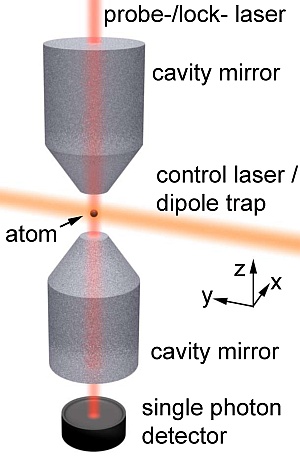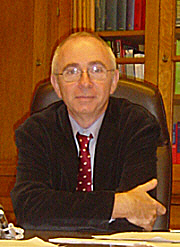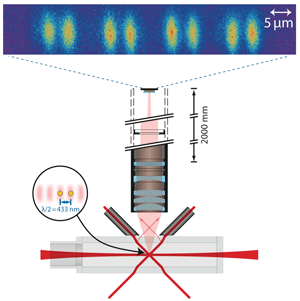
The goal of cavity quantum electrodynamics (cavity-QED) is to investigate and understand light-matter interaction at the most fundamental level by preparing a basic model system: a single atom strongly coupled to a single photon in a well-controlled environment. While individual atoms can be controlled well by laser-cooling and trapping techniques, photons have to be confined by reflecting them back and forth in cavities, which thus act as a "trap" for light.
In such a system the physics behind spontaneous and stimulated emission of light and the associated transitions of the atom between different quantum states can be investigated and illustrated in a unique way. This becomes possible due to the strong coupling between the atom and the cavity field, enabling a single atom to control the transmission of light through the cavity, and allowing a single photon to deterministically change the state of the atom. Quantum communication could be a future application of these controlled interaction between individual photons and atoms.
 We are very glad to host Jean-Michel Raimond in our group for about 10 weeks. Jean-Michel Raimond is Professor of the Université Pierre et Marie Curie and former director of the Physics departement at the Ecole Normale Supérieure. He devoted is research to the exploration of interaction of light and matter at the most fundamental quantum level at the Laboratoire Kastler-Brossel, where he is a very close collaborator of the recent nobel laureate Serge Haroche. His stay in Bonn is supported by the Alexander von Humboldt foundation, from which he has been recently awarded the Humboldt Prize. We are enjoying a fruitful scientific collaboration!
We are very glad to host Jean-Michel Raimond in our group for about 10 weeks. Jean-Michel Raimond is Professor of the Université Pierre et Marie Curie and former director of the Physics departement at the Ecole Normale Supérieure. He devoted is research to the exploration of interaction of light and matter at the most fundamental quantum level at the Laboratoire Kastler-Brossel, where he is a very close collaborator of the recent nobel laureate Serge Haroche. His stay in Bonn is supported by the Alexander von Humboldt foundation, from which he has been recently awarded the Humboldt Prize. We are enjoying a fruitful scientific collaboration! 









